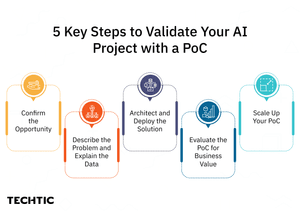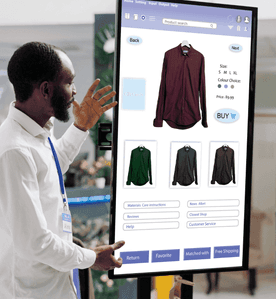5 Steps to Create an AI Proof of Concept to Minimize AI Development and Adoption Risks
Sector: Digital Product
Author: Nisarg Mehta
Date Published: 10/03/2024

Contents
AI remains one of the fascinating technologies that are being applied today to improve solving of problems in different fields. However, the process of establishing efficient AI utilization is not linear, particularly if the companies are involving third-party AI applications.
53% of companies have no internally developed AI at all and instead only use third-party tools, which creates a huge number of unaddressed risks. Such risks can be mitigated through an AI Proof of Concept (PoC), a way to experiment and prove the value of AI solutions in an organization.
A properly designed PoC assessment can prevent certain problems, assist in determining whether the AI strategy will be useful for the company, and minimize the risks of the project’s failure.
Let’s understand what an AI PoC is and evaluate the implication of the concept of mitigating risks in AI advancement.
What is AI Proof of Concept?
An AI Proof of Concept (PoC) is a critical element of adopting and deploying artificial intelligence in an organization. This is the conceptualization of AI solutions to demonstrate where they can fit, work, or be implemented. An AI PoC is applied in order to validate the assumptions, algorithms, and models, which are necessary in case of large and full-scale implementation.
Risk Mitigation Through PoC
A strong rationale for doing an AI PoC is to reduce the risks that come with the integration of AI. Recall that a large number of AI failures are associated with third-party tools. By creating a PoC, the tools needed can be tested in the business context to find problems and solve them before they become major issues. This is important in order to prevent making terribly wrong decisions at some point in the future.
Business Value Validation
An AI PoC can also help organizations test the business benefits of AI technology. Before the implementation of the AI solution, it is necessary to make sure that it is Suitable for the organization and brings profit. A PoC aids in identifying whether the intended problem will be solved by the AI application and whether it will be valuable to invest in. This validation step is particularly important in industries that have just started implementing AI and where there may be doubts about the efficiency of the approach.
How to Create a PoC for Your AI Project?
Here are 5 steps to building a PoC to validate your AI idea:

Step 1: Confirm the Opportunity
The first stage of the AI PoC is the confirmation of the opportunity. This involves setting the expectation of what the AI solution is expected to accomplish and why this is relevant to your company. One must distinguish what problem AI will help to solve and determine if AI is even suitable for it.
Understand the Opportunity To get started, determine which aspects of your organization are most likely to benefit from AI and in which way this can be done. Reflect on what has been done in your field of business with AI and look for such possibilities in your own enterprise. This may mean considering issues such as how to improve customer experience, logistics, or maintenance, where artificial intelligence can make a difference.
Industry and Business Relevance: The AI opportunity may be defined; the PoC has to be focused on the particular industry issues and business problems. For example, if you work in an industry that requires the processing and analysis of data sets, then, AI is useful. However, the PoC should be designed to address the specific needs of your business; to be realistic, and provide tangible benefits.
Before going any further you should ensure that you have enough funding and support from the management for your Proof of Concept. This step is crucial for the success of the PoC process as it ensures that the efforts are supported by key stakeholders.
Step 2: Describe the Problem and Explain the Data
The next step is to define the problem that you are going to address with the help of AI and, therefore, to describe the data that will be used for that. This phase entails efforts to obtain more information about the problem and the validity and relevance of the data that will be used to train the AI systems.
Data Profiling and Problem Definition.
First of all, the problem has to be defined in this case. This is because the problem can be placed into different classes of generic AI like reasoning, perception, computer vision, and so on. For example, if the problem is about understanding text data, then, Natural Language Processing (NLP) is the right approach to the problem. If the data is visual in nature, this means that you are working with image data, then it is computer vision that would be used.
Second, is the data that will be fed into your AI models. The phase of data profiling is important where you have to identify the quality, amount, and types of data. This analysis will assist you in whether the data obtained is sufficient to solve the problem in the best way. Questions to consider include:
- Is the data you are using in fact a proper sample of the kind of problem you are tackling?
- Is it bias-free, and does this have no factor that may affect the way the Artificial Intelligence will think?
- How can you protect data and privacy if data is considered the most important?
By asking these questions you will be able to determine any issues that may arise early on and therefore it will create a sound foundation for the AI PoC.
Step 3: Architect and Deploy the Solution
The problem has been described and the data analyzed so the next step is to design and implement the AI solution. This includes determining the technical architecture that would integrate with the AI model, identifying the right tools to use, and identifying the right approach to deployment. This stage includes the following:
Design and Implementation
In this stage, you need to come up with a detailed plan on how the AI solution is to be implemented. The architecture should include:
- Underlying Products and Systems Infrastructure: Identify the hardware and software that will underpin your AI approach. This encompasses the decision of whether to deploy existing architecture or to build a new architecture that is dedicated to AI tasks.
- AI-Specific Software: Choose the right AI tools that you will be using in your solution for the right implementation. Whether you need an open-source solution or a closed-source program that has certain features built-in, you can choose one.
- Enabling Frameworks: You should choose a proper set of frameworks that can be used to implement the intended AI solution and these are TensorFlow or PyTorch depending on the intended AI application and the intended objectives.
- Visualization and Front-End Tools: The same is true for how the results will be presented to the end-users (for instance, by designing individual dashboards or using the available data visualization tools).
Build vs. Buy Decision
The decision of whether to build the solution in-house or to buy the solution in the form of components is also important. On the same note, while cloud service can be used at times to expand the business and deploy quickly at low cost, this has to be done while taking into consideration the aspect of customization and control.
Model Construction and Training
After the above steps, the architecture is defined the subsequent step is to construct and train the AI models. This is the heart of the AI PoC, whereby a data scientist populates the data from the profiles to train models, adjust the parameters, and perform round-robin testing. As a result, the approach aims to obtain a model that would work effectively in the context of the PoC but would be extensible for potential future needs.
This step is computationally costly and the scheduling of the available computational resources is an important task. Tools such as the one from Intel allow for better optimization of the training process and also time as well as improving on the overall outcome of the model.
Step 4: Evaluate the PoC for Business Value
The following question should be asked when the PoC has been developed with the inclusion of the AI solution; How effective is the solution and how profitable is it?
It is important to check if the AI model being developed fulfills the success criteria set at the very beginning of the project and if it brings some value to the company.
Assessment Criteria
To effectively evaluate the PoC, several key criteria should be considered:
- Accuracy: Ensure that the accuracy of the AI model is satisfactory as well as the reliability of the results for the particular set of results. Do the information or the predictions of the model make sense and are they useful?
- Completeness: See to it that all the data that the AI solution is to apply is fully applied to the best of its ability. All relevant information must be provided and no important source of information should be omitted.
- Timeliness: In this case, to make sure that the information given to the AI model is accurate or relevant when it is needed. To illustrate this further, consider a predictive maintenance application, the alarm messages from the AI must be sent out earlier than the failure.
Explainability and Fairness
Can one describe the behavior of the AI and its actions? This is particularly so where AI is used in decision-making processes whose implications concern people such as in the provision of employment or a credit rating. Ensure that there is no racism in the model and the decision is not made in a prejudiced way.
Scalability and Flexibility
The proposed AI solution has to be considered by how well it can scale up to handle the future problems that it is expected to solve if the complexity of the problems is to increase in the future. How will it behave when data or the number of users grows? Also, it is necessary to evaluate the possibility of adjusting the solution to particular needs. Is it capable of responding to the changing business requirements or to the shift in the data environment?
Hence, if a company wants to invest in an AI PoC, the above parameters should be used to determine the viability of the PoC, before its full implementation.
Step 5: Scale Up Your PoC
When the AI Proof of Concept (PoC) process has been completed and the solution has been proven to deliver business value, the next step is to extend the solution. The process of scaling up is to move from the PoC to the actual system which is capable of handling large amounts of data, more users, and multiple business uses.
Challenges of Scaling
The use of AI solutions is not as simple as merely upscaling the resources. There are numerous cases where the behavior of an AI system is not linear and as such if the computational power is increased say by a factor of two then the system may not be twice as fast. It is also important to validate and optimize this approach in multi-node mode since the proposed solution has to deal with such a workload.
Infrastructure and Optimization
Check if there is any limitation that may affect the system. This involves the assessment of the network, storage, computing, and other dependent hardware to establish if the system can support the large scale. There are circumstances in which you may have to alter or modify some of the steps to enhance their effectiveness. Also, the AI models can be further refined as more data is generated in the future for the models.
Scaling to Other Business Situations
Since the PoC is proven to be effective in one part of the business, it can be used in other parts. For example, if the PoC was done for predictive maintenance in one line of the manufacturing process, it can be taken to other lines of the process or to other business units. This approach assists in enhancing the comprehensiveness of the value of the AI solution in the organization.
Long-term Management and Operations
Yet, the final step is to address the long-term use of the AI solution. You may need to fine-tune the models and bring them up to date whenever there is new data or the business changes. Ensure that the company has all that it needs to enable the effectiveness of the AI system in the future such as the tools, policies, and staff to monitor, update, and train the AI system.
To make sure that you get the most out of the PoC while at the same time avoiding the challenges that come with large-scale implementations, you should consider scaling the PoC properly and embedding it within the larger business environment.
Final Note: Align Your Key Stakeholders to the Process
Developing an AI Proof of Concept (PoC) is critical in any organization aiming to integrate AI solutions. A good PoC makes it possible for organizations to trial and prove the concept of their AI solutions in a safe environment thus lowering the risks that come with AI implementation and enhancing the chances of the idea being in line with the organization’s strategy. In this way, it is possible to establish a clear roadmap for any AI project, from the identification of the opportunity, through problem and data definition, solution and deployment, business value assessment and finally scaling up.
Leadership is a part of the entire process to ensure that not only the PoC is solving the technical problems it also solves the business problems. Through leadership and concern for governance, other AI applications can be built within organizations that are efficient but also right and correct.
Since AI is still growing and plays an increasingly important role in business, beginning with a PoC can be crucial for the further effective implementation of AI. This is helpful in that organizations can begin their AI projects knowing that the solutions that they are deploying have been well-tested and are likely to be beneficial.



